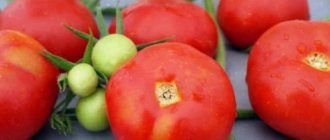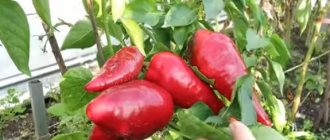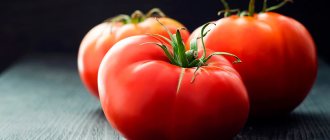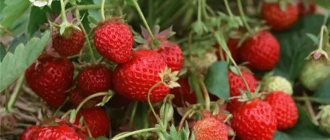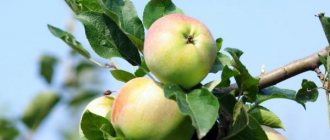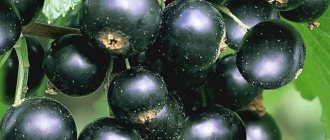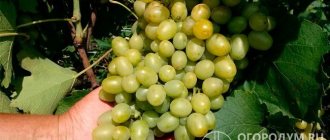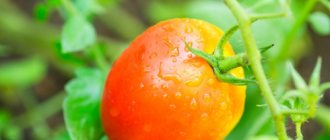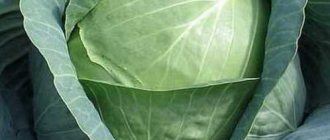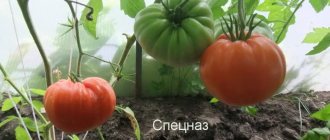Golden domes are a tomato that guarantees rich harvests of delicious tomatoes. This is a 21st century variety, bred by the Siberian breeder V.N. Dederko.
| Height | Landing location | Ripening time | Fruit color | Fruit size | Origin | Fruit shape |
| Medium height | Greenhouse, Open ground | Mid-season | Orange | Large | Variety | Flat-round |
History of variety development
Siberians are constantly looking for varieties of tomatoes that will be tasty, productive and, most importantly, resistant to extreme weather conditions.
Applicant for the introduction of a variety into the register of breeding achievements of the Russian Federation Dederko V.N. The city of Novosibirsk submitted an application to test the Golden Domes tomato variety in 2003. For two years, 12 breeding stations across the country tested the variety. And in 2005 he was included in the register. Patent number 2907.
The registration commission recommends the tomato variety “Golden Domes” for cultivation in all regions of the country as:
- salad;
- determinant;
- mid-season;
- with a flat-round shape of fruits of orange color.
The authorship belongs to a group of breeders from Siberia: S.V. Ugarova, V.N. Dederko, T.N. Postnikova.
Advantages and disadvantages
The main advantages of tomato:
- Sweet, sugar tomatoes. It is for its taste that gardeners love tomatoes. Homogeneous pulp, without veins, with a small number of seeds.
- Fast maturation. Tomatoes are considered early ripening. The period from the first shoots to fruit maturity is no more than 90-95 days.
- The bushes take up little space due to the dense planting allowed. Up to 6 plants can be placed on one square meter.
- High yield. From 1 m² you can collect up to 12 fruits, which is above average. A few bushes are enough to get a rich harvest.
- Tomatoes are resistant to environmental influences and frost. High immunity to fungal diseases.
A few disadvantages include:
- Possibility of stem breaking under the weight of tomatoes. The bush requires support and garters.
- The fruits may crack. This problem can be avoided by properly organizing watering.
- This is a hybrid, so the seeds cannot be used for replanting.
Description of the variety
For more than 15 years, vegetable growers have been happily growing the “Golden Domes” tomato in their gardens and greenhouse shelters. The excellent taste of huge tomatoes from year to year forces the variety to be given to the most fertile areas of the garden.
Unpretentious bushes
An adult, fruit-bearing bush does not grow higher than 1 meter. Some vegetable growers indicate 1.2 m with additional feeding.
The bushes form into one or two shoots; the bush will not be able to bear any more huge fruits.
Determinate variety. Its shoots do not grow indefinitely, but end in a flower cluster. The leaves are medium in size and light green in color. The inflorescence is simple. The first is laid above the 8th sheet, then after 1-2. Each inflorescence bears 3-4 fruits.
Unique fruits
Golden Dome tomatoes are unique - they are delicious giants.
Size range
When entering the variety into the register, the average weight was assigned figures with a fairly broad limit of 215-400 g. At the same time, the lower clusters bear larger fruits than the upper ones. This is understandable; nature has allocated more time for growth and maturation.
The top tomatoes, closer to autumn, are already feeling the waning days. They try to somehow take care of their seed in order to leave offspring and decide to stop growth in order to ripen.
When at least one tomato begins to ripen, it releases ethylene gas. Under its influence, the remaining tomatoes stop growing and the ripening process begins. That is why it is very important to increase growth by removing brown tomatoes and ripening them outside the garden bed.
Form
When registering the variety, the commission described the fruits as:
- flat-round;
- slightly ribbed;
- fleshy.
The fact that a variety is called “Golden Domes” does not mean that the fruits must be heart-shaped or elongated. Some vegetable growers note that one bush can bear both flat and slightly oval fruits. This is normal, but it is the flat-round fruit that is an indicator of the variety.
When purchasing seeds, sometimes you can see a heart-shaped fruit on the bag, this is not correct. The manufacturer, and especially the packer, did not delve into the essence of the issue or produced counterfeit packaging.
Coloring
According to the register, the color of the fruit is orange. However, according to vegetable growers, it may change. The color may be slightly paler or richer depending on:
- soil acidity;
- weather conditions;
- elements in fertilizing solutions.
Large, first fruits are deep orange in color both outside and inside. Those tomatoes that are smaller may have a yellow color.
Diet pulp
It’s not often that the registry uses the word “fleshy” when describing varieties. But with the tomato variety “Golden Domes” this is exactly the case. When cutting a fully ripened tomato, no hollowness will be visible. Few seeds are found directly in the pulp of the fruit.
Tomatoes do not release juice even after being chopped for a long time.
This feature makes the fruit desirable for making salad. This gives hope that 2 minutes after serving, the dish will not turn into a mess with floating ingredients.
The taste deserves special attention. According to the tasting assessments, it received “excellent”. This means that in all regions of the country tomatoes acquire a balanced, even taste. The ratio of organic acids and sugars is so impeccable that even picky gourmets agree with the excellent rating.
Usage
Salad tomato. Beautiful, orange, huge fruits, even with a strong desire, will not fit into the jar. However, chefs manage to cut them into even segments and roll them up in the form of salads, as well as fill them with marinades and jelly fillings.
The dense skin of the tomato cuts easily and does not crack under the influence of temperature factors. This allows you to make the preparations not only tasty, but also beautiful. Excess tomatoes and poor quality are sent for processing.
Video
We invite you to watch a video review of the “Golden Domes” tomato variety:
| Late ripening | Early ripening | Mid-late |
| Bobcat | Black bunch | Golden Raspberry Miracle |
| Russian size | Sweet bunch | Abakan pink |
| King of Kings | Kostroma | French grape |
| Long Keeper | Brawler | Yellow banana |
| Grandma's gift | Red bunch | Titanium |
| Podsinsky miracle | The president | Slot |
| American ribbed | Summer resident | Krasnobay |
If you find an error, please select a piece of text and press Ctrl+Enter.
Main characteristics
Considering the “Golden Domes” tomato variety, the main characteristics are as follows:
- mid-season;
- salad;
- determinant;
- delicious;
- requiring garter and shaping;
- productive.
Of course, every gardener will want to try a tomato with such characteristics. According to reviews from those who have already grown, once you have grown a variety in the garden and tasted the tomato, you will always have room for several bushes.
Advantages and disadvantages
All the advantages are spelled out in the characteristics of the tomato. However, any variety has a downside, “Golden Domes” is no exception:
- With an average yield, the variety has only 76% yield of marketable fruits. If a vegetable grower manages to collect 10 kg per square meter of garden area, then only 7 kg can be sold as quality products. The remaining tomatoes will need to be processed.
- The second disadvantage is the average sensitivity to major tomato diseases. The variety registry does not provide any guidance regarding the variety's immune response. This means that the variety requires preventive treatments.
- The third drawback, rather a feature, is the variety’s demands on formation and reliable fixation. Very large fruits can break the shoots, and the harvest will be lost.
All these disadvantages are not so great compared to the fact that the vegetable grower will receive a large, tasty and beautiful tomato.
Productivity
The “Golden Domes” variety has legalized yield limits of 10.5-13.6 kg per square meter of garden area. Please note that this figure is average. Gardeners who grew the variety unanimously claim that the variety is very responsive to:
- watering;
- feeding;
- soil fertility and composition;
By improving agricultural technology and trying to optimally create conditions for the variety to bear fruit, you can remove a significant amount of large, beautiful tomatoes from one bush.
Resistance to diseases and pests
The registration commission does not provide any indication of the variety's resistance to any diseases. This means that the variety is moderately resistant and requires preventive treatments.
Area of application of fruits
It’s a shame to waste quality surplus products for processing, but the variety has only 76% of the yield of marketable tomatoes. This means that 24% may be crooked, cracked, or doubled in the stem area. These are the products that are allowed for processing.
From substandard tomatoes they make:
- juice;
- sauce;
- ketchup;
- pasta;
- adjika.
To improve the organoleptic properties of tomato products, red tomatoes are added to orange ones.
The high dry matter content of tomatoes makes it possible to obtain excellent processed products. The juice and sauce comes out thick, rich and very tasty.
How to grow tomatoes
The seedlings are ready for planting in a permanent place in 50 - 55 days. Fertilizers such as humus, compost or peat are first added to the soil.
Tomatoes need to be planted in two rows, with the seedlings of the first row in relation to the seedlings of the second row placed in a checkerboard pattern. The distance between bushes is at least 50 cm, and between rows - 40 cm.
Watering is most important during the flowering and fruit set stages. Without a sufficient amount of moisture, pollination will not occur, and those fruits that have time to set will not gain weight. Water tomatoes at the root, which prevents fungal diseases.
Water 2 times a week in the evening, 2 liters of water for each seedling. A good conductor of water is an ordinary plastic bottle without a bottom. It is installed at a shallow depth in the root zone and filled with water, which gradually penetrates to the roots.
After watering, weeding and loosening of the soil is necessary. These simple steps not only provide oxygen access to the roots, but also help in pest control.
Mulching beds with straw is another preventive measure that keeps beds moist longer.
A determinate plant requires obligatory garter, since heavy fruits can break not very powerful stems. Vertically stretched ropes or wooden stakes serve as a strong support.
In addition to the garter, mandatory stepsoning is required.
Pinching involves removing additional stems that appear in the axils between the main trunk and the tomato leaf. In one season there are up to 50 stepsons on a plant. If they are not removed, then the excess of branches will not allow the fruits to gain the proper weight.
Vegetables planted in street beds are grown in 3-4 fruit stems, and in a greenhouse - in 1 stem. Growing in a greenhouse involves dense planting and tying to a rope support.
The formation (stepchildren) of a culture depends on the region in which it grows. In the northern regions, the best fruiting rate is observed when growing in 2 trunks, in the southern regions - when growing in 3-4 trunks.
To limit plant growth, pinch the top.
To achieve maximum fruiting, they resort to specialized preparations. For example, boric or succinic acid increases the number of ovaries in each cluster, and growth stimulants (Biostin, Rhizome) help to quickly gain root mass.
Diseases and pests
Despite its Siberian character, the plant is susceptible to diseases such as late blight, verticillium wilt, and blossom end rot.
Fungicidal agents, for example, Oksikom, help in the fight against these diseases. Treatment with fungicides is also carried out for the purpose of prevention.
Calcium nitrate successfully combats blossom-end rot by watering and spraying the plant.
In the fight against late blight, the main role is given to Bordeaux mixture or Fitosporin. These drugs destroy the cause of the infection, and the affected parts of the plant should be burned. Copper sulfate is used as a preventive measure against late blight.
As for insects, they are not averse to taking over vegetable beds and causing considerable harm to plants. These are known to every summer resident: mole crickets, spider mites, gnawing cutworms, Colorado potato beetles, and slugs.
Beds covered with wood ash and tobacco dust save tomatoes from pests, as does regular inspection of the bushes.
Slugs and Colorado potato beetles are collected by hand, and mole crickets are scared away from the beds by pungent odors.
Spider mites live in a greenhouse, so there is a need for regular ventilation in order to destroy the conditions for the existence of the parasite.
Insecticides also help protect against parasitic insects. But remember that treatment with them is possible 1 month before fruiting.
Planting seedlings in a permanent place
Seedlings are planted at the age of 2 months. By this time it should be: strong, stocky, with well-developed 6-7 pairs of true leaves.
Preparing the bed
When choosing a place to plant tomatoes, you need to take into account that the area should be:
- protected from the prevailing winds;
- with fertile light lands;
- with neutral or alkaline soils;
- free from weeds;
- without nightshade predecessors;
- no flooded areas.
Counting on a good harvest, the best plot in the garden is allocated for tomatoes.
Disembarkation scheme
“Golden Domes” tomatoes are planted according to the following scheme:
- distance between bushes - 50-60 cm;
- the distance between rows is 60-70 cm.
Those vegetable growers who try to compact plantings should understand that this can only be done on poor soils without fertilizing. In this case, the vegetative mass will not be lush, but the harvest will be very small.
Transfer rules
Usually seedlings are transplanted at the age of 55-60 days. During this period, the sprouts have time to grow a good root system and above-ground part.
The optimal time for transplanting into a greenhouse is the first half of May, into open ground - the last ten days of May.
Before planting, tomatoes are accustomed to fresh air and sunlight - they are regularly taken outside in the morning and kept for several hours. Two days before transplanting, the plants are left to spend the night in the fresh air.
Preparing the bed
Tomatoes love loose, light, soil with a neutral pH level. Choose a place where legumes, cabbage of any variety and root vegetables previously grew.
The bed is prepared in the fall - it is cleared of plant debris, weeds, sprinkled with organic matter (a bucket of compost or humus) and mineral fertilizers (3 kg of wood ash and 100 g of superphosphate and potassium sulfate). If deoxidation is necessary, add 300 g of slaked lime or chalk. Then they carry out digging, leveling and watering.
In the fall, when digging the soil, do not break up the clods of earth, much less water them, because... the upcoming autumn-winter precipitation will do this itself. If you loosen the soil after digging, it will float over the winter and you will have to dig it up again in the spring. Autumn digging is carried out in blocks. This method of cutting the soil allows it to be well saturated with moisture over the winter, but at the same time in the spring it quickly dries out and is ready for processing.
In the spring, 2 weeks before the planned transplantation of bushes, the area is sprayed with a urea solution - 2 tbsp. l. for 20 liters of water. This component improves the nutritional composition of the soil and kills all kinds of parasites that have survived the winter in the ground. After irrigation, the soil is dug up and leveled.
Disembarkation scheme
The holes are prepared according to the 50x60 cm pattern. For a bed of 1 m², 5-6 bushes are enough. Each hole is spilled with 1 liter of water. After absorbing moisture, the roots are lowered, sprinkled with earth, lightly compacted and hilled to ensure the stability of the seedlings.
Compaction of the soil after planting any seedling or seedling is a prerequisite. This allows you to create good contact between the roots and the soil. You just need to compact it carefully so as not to damage the roots.
In the first days, seedlings are very sensitive to sunlight and night temperature. Therefore, at midday it is covered from the sun, and in the evening it is covered with film.
The best option for such a covering is agrofibre, or white non-woven material: Agrospan, Spunbond. It will protect plants from the hot sun during the day and from low temperatures at night.
How to care outdoors
With good care, Golden Dome tomatoes will show their full genetic potential not only in terms of gross yield, but also in terms of taste.
Watering, loosening and mulching
Watering the tomato should be:
- regular, but not frequent;
- deep, until the soil in the area of the root system is completely wet;
- in accordance with natural moisture.
Attention! Tomato consumes nutrients only in dissolved form. The soil is dry and growth has stopped.
Young plants need loosening. When a tomato has already entered the ovary stage, there is no point in loosening the soil. But mulching is necessary when there is little moisture and it needs to be protected. In this case, mulch materials are placed around the tomato stems.
Top dressing
To feed tomato bushes, use nutritious mash, which is prepared from organic or mineral fertilizers. For this you can use:
- pork, cow or horse manure diluted 1:10;
- chicken manure diluted 0.5:10;
- ammonium nitrate solution 20 g per 10 liters of water;
- superphosphate solution 25 g per 10 liters of water.
The prepared solution is left to stand for a day. Next, add a liter of concentrated solution to 1 bucket of irrigation water.
Under each bush, 0.5 liters of fertilizer is poured at intervals of 15-20 days.
Stepsoning
If the “Golden Domes” tomato is formed into one shoot, then all the stepsons are removed when they reach a size of 2 cm.
If the formation is planned in two shoots, then the lower stepson is left, and all the others are removed.
Soil care
The soil under tomato plantings must be clean. Weeds attract:
- moisture;
- nutritional elements;
- light.
In addition to competition, they also serve as a home for insect pests and pathogens of tomato diseases.
Tying up a bush
The large-fruited tomato “Golden Domes” will tilt the shoot toward the ground as the fruit grows. This cannot be allowed. You need to tie up the bush:
- regularly;
- soft twine;
- with the capture of expanding fruits.
Timely garter guarantees an even stem and the safety of the crop.
Agricultural technology
Proper cultivation is the key to the future harvest. Fulfilling all requirements will allow you to get a high yield.
Preparing and planting seeds
Before you plant the seeds, you need to check them. Dilute 1 tbsp in 1 liter of water. spoon of salt, pour the seeds there. Those that float are not suitable for landing. The rest are washed and dried.
For 30 min. the seeds are dipped in a solution of potassium permanganate. Then rinse with warm water and dry.
For planting, mix the soil:
- 1 part of turf land;
- 2 parts humus;
- 1 part river sand.
Water with a weak solution of potassium permanganate and make furrows at a distance of 5 cm, 2-3 cm deep. Sow dried planting material. Sprinkle with earth and cover with polyethylene. Place in a warm, dark place until sprouts appear.
See also
Description of the early ripening hybrid tomato Captain F1 and cultivation techniques
Read
Care and planting of seedlings
Plants require high-quality care, as the foundation for the future harvest is laid. Loosening is carried out after each watering.
Diluted manure and complex mineral compounds are used as fertilizers.
When the second true leaf appears, pick the tomatoes into separate containers. Summer residents advise using peat pots. This way the root system is not disturbed when transplanting to a permanent location.
The date of planting in a greenhouse or soil is determined by the summer resident independently. The bed is prepared in advance, watered and holes are made. The distance between bushes is 40 cm, between rows 50 cm.
How to water
Watering the seedlings is carried out in a timely manner, as the top layer dries. You can’t overwater, but the plants shouldn’t dry out either.
At first, they irrigate the ground with a spray bottle, so the roots of fragile seedlings are not washed out. Then water carefully between the grooves. Make sure that the roots are not eroded.
Conditions for maximum fruiting
Following simple rules will help you get the maximum yield:
- correct landing;
- selection of location and soil;
- implementation of agricultural techniques;
- formation of bushes;
- introduction of fertilizing;
- timely watering;
- mulching and loosening.
Compliance with planting requirements and recommendations of experienced summer residents leads to an increase in yield.
Diseases and pests
The variety has average disease resistance.
Under unfavorable weather conditions, tomato plantings may be affected by:
- late blight;
- fungus that causes cladosporiosis. In this case, the leaf becomes covered with yellow spots, they merge and the leaf blade fades;
- ascochyta blight or stem cancer. Exudation of tissue fluid appears on the shoot; vegetable growers call it gum. The shoot gradually dies off.
- anthracnose. The fruits become covered with spots, then they merge and the tomato becomes mummified.
Pests also affect the variety to a moderate extent. The greenhouse whitefly and the Colorado potato beetle do not bypass plantings, especially if there is nothing more tasty nearby.
Disease and pest control
Well-proven drugs are used as plant protection products for tomato diseases:
- “Fitosporin-M, for cladosporiosis;
- “Quadris” - for late blight, anthracnose, powdery mildew;
- “Novosil”, “Strobi” - for anthracnose;
- “Trichodermin”, “Rovral” for ascochytasis.
Advice. When purchasing drugs, you should carefully read the instructions and consult with the store manager before purchasing the drug.
Preventative treatment
Daily inspection of tomato bushes will allow you not to miss an important point. When the pathogen just begins its pathogenic work, it is much easier to strangle it.
The first preventive treatment is carried out during the period when:
- warm days give way to cold nights;
- the season of prolonged rains begins;
- plants are covered with morning cold dew.
All these conditions contribute to the proliferation of fungi. By spraying with a solution prepared in accordance with the instructions for the drug, you can prevent the rapid multiplication of the pathogen.
Advantages and disadvantages
The plant has positive and negative characteristics. The summer resident will have to evaluate the merits of the tomatoes and the quality of the plants themselves.
Advantages:
- Taste characteristics.
- The best variety for dietary nutrition.
- Does not contain acid.
- Stores well unripe.
Flaws:
- Requirement for formation.
- Prone to cracking.
- Unsuitable for canning entirely.
Experienced summer residents eliminate shortcomings by showing ingenuity.
Photo
Looking at the photo of the “Golden Domes” tomato, you can see both flat-round and slightly elongated fruits. According to the testimony of vegetable growers, the same bush can produce such different forms.
The photo clearly demonstrates the large-fruited tomato.
Use of fruits
The large-fruited nature of tomatoes does not allow the use of vegetables for whole-fruit canning. Therefore, summer residents use Golden Domes for:
- juices;
- seasoning dishes;
- fresh salads;
- refilling preserves in winter;
- preparing winter platters, where tomatoes are cut into slices, and much more.
The use of tomatoes in home cooking depends on the imagination of the housewife and the wishes of the household.
What varieties (hybrids) of tomatoes will you definitely plant next year?
Valentina Grigorieva
“Budennovka” and “Japanese Truffle” (orange) are my favorites.
Nusia
I really liked the Celebrity variety. Vintage, one-dimensional. I recommend it to everyone!
olga
Every year I buy different ones, but the rule is the same They are either yellow or black Red only cherry tomatoes Favorite variety Black Moor
Tane4ka
I really enjoyed The Crimson Giant. I thought there would be 3-4 huge tomatoes, but it turned out to be a very tall bush, and there were a lot of fruits, but all of them were medium in size, raspberry in color and unusually sweet. It turned out to be resistant to diseases, very productive and very tasty. The household members first of all picked them out.
Lena
I think I’ll definitely plant a black De-barao, maybe also a yellow one, something cherry, maybe a date, and large-fruited ones, whatever the eye catches, but definitely in different colors - yellow, orange, red, black
Lariska rat
there should be Seminis on the packaging, the website has information in pictures of what it looks like: https://www.semagro-msw.ru/katalog_semjan/on-line/tomat-indeterminantnyj/page1/
Evgenia Taratutina
I will only plant my own tomatoes, planted for many years. - with guaranteed taste and harvest.
Mityai Bukhankin
next year 2 varieties and 2 hybrids. and some untested things. I’ll also sow what I want to check for truth, whether it’s a hybrid or not.
LARISA ZHUKOVA
There is only one hybrid - Evpator. The remaining varieties are mostly our own.
Irina Murzinova
I will definitely plant Pink Honey, Honey Spas, Persimmon, Malachite Box.
Tatyana Pavlova
I always plant the Dimensionless, Novichok, and Orange Giant varieties. I won’t experiment with varieties anymore, I’ll reduce the quantity. And then I listened to enough advice and started off again... Today I again heard a woman looking for the Champion variety; she praised it very much.
always elegant
From cherry trees I will plant Ira (F1), Red date. I’ll refuse red cherries (in winter, similar watery cherries with greenery are sold in markets) - they lose out to the previous ones. I’ll leave De Barao pink and black, Japanese truffle (red), give up 100 poods of tomato, and return again to Bull’s Heart. And I’ll plant the Russian Apple tree outside (neat round tomatoes - well, just right for pickling!) And I bought the Persimmon variety to try. I will definitely do this. Well, I’ll catch up with something else there. I have 24 varieties of tomatoes. (bags), but only 35-40 roots will fit into the greenhouse (but I also want to plant 5 peppers and 3-5 cucumbers there)
Fox@
Next year I decided to plant only large-fruited ones so that I can eat them from the heart) ) I have already purchased several varieties: Lemon Giant, Olesya, Sevruga, De Barao Giant, Honey Spas, Eagle Heart, Gypsy, Ob Domes, Golden Queen, Chocolate Miracle, Constellation twins.. This is from the new one, and from the old one I will plant Lezhkiy, Japanese golden truffle and Black Pear...
